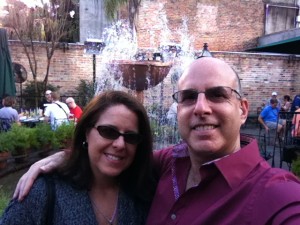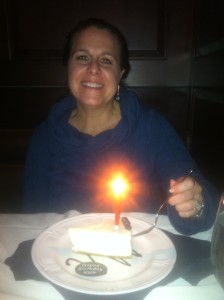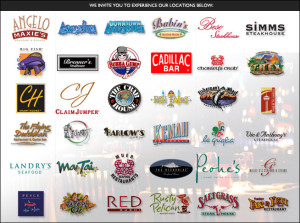 Steve Sipress
Head Rhino & Chief Strategist
Steve Sipress
Head Rhino & Chief Strategist
Effective Loyalty Program Options

In front of the Courtyard Fountain at
world-famous Pat O’Brien’s in New Orleans
My beautiful wife Michele and I visited the party city of New Orleans last week during the start of Mardi Gras. While I connected with some old friends and made some new ones at Yanik Silver’s “Underground X” event, Michele spent a few days exploring some of the rich history and art in and around the world-famous “French Quarter.”
We ate most of our meals together, and devised a two-part plan:
- To always have excellent dining experiences; and
- Not to eat in the same place twice.
I am happy to report that we succeeded on both goals, in large part to asking A LOT of questions of locals as well as tourists.
[*Check out our photo album “New Orleans – February 2014” on Facebook.]
Because we wanted to experience the very best of the “local flavor” New Orleans is so well-known for, we also decided to avoid all in-hotel and chain restaurants.
Unfortunately, we failed on both of those counts. Here’s why…
For Michele’s birthday dinner on Saturday night, we enjoyed a fantastic meal, including outstanding food, service and live entertainment, at “The Rib Room.”

Happy Birthday Michele!
Only after our meal was over, we exited the restaurant through a different door than the one we entered and discovered that we were in the lobby of the Omni Royal Orleans Hotel.
We checked out some amazing artwork and furniture in the lobby, and listened to an amazing jazz singer, but realized that we had unwittingly failed to reach our goal of avoiding “in-hotel” restaurants.
Another night, we asked a woman in one of the many Visitor’s Centers that are all around the French Quarter for a recommendation of a top seafood restaurant nearby. She suggested “Landry’s Seafood,” and drew a big “X” on a street map for us.
As we approached the location where “X” marked the spot, I remarked how out-of-character it was to see a row of chain retail stores on the block leading to where the restaurant was on the corner. We had spent so much time exploring the local, boutique specialty stores in the area that we were a little surprised to see “Urban Outfitters,” “H & M” and “Foot Locker,” among others, as we neared the restaurant.
Again, it was only after we finished our meal that I picked up a brochure for their “Landry’s Select Club” frequent dining program, and noticed that we had, contrary to our original plan, eaten in a chain restaurant. Michele and I looked around the restaurant for clues we may have missed, but sure enough, everything looked like it was part of a “local” place and not a chain.
I couldn’t have been more wrong.
As the brochure explained, there are 19 “Landry’s Seafood” locations around the U.S., with the first one operating out of a private home in Lafayette, Louisiana in 1947.
But that’s not all.
The “Landry’s, Inc.” company currently owns and operates nearly 500 restaurants around the world, including a number that we’ve dined in, such as Morton’s Steakhouse, McCormick & Schmick’s, Rainforest Cafe and Claim Jumper.

Landry’s, Inc. operates nearly 500 restaurants
I guess I really could have paid more attention to the Big Restaurant Business world, but alas, we failed in our quest to avoid “chain restaurants” during our time in New Orleans (and also realized why we had passed a string of retail chain stores all along the same block as Landry’s).
Anyway…
Back to “Landry’s Select Club” – their frequent-dining rewards program.
Even though Michele and I were enjoying a great meal, in a nice restaurant, in a city almost 1,000 miles away from home, I still couldn’t turn off the marketing-minded part of my brain. I just had to examine the way they run their program, and look for the good and the bad parts of their strategy.
Here’s what I found…
They could have done what most restaurants do and let everyone join their loyalty rewards program for free. But instead, they they charge a $25 up-front enrollment fee, which is refunded in the form of a $25 credit on the member’s next visit to any of their restaurants. (Members also get an annual $25 “Birthday Reward,” plus loyalty points and other benefits.)
So here were my immediate thoughts…
One of the biggest advantages large companies have over small businesses (and, indeed, one reason they grow to become big) is that they do a fantastic job of tracking EVERYTHING.
Therefore, it’s my belief that they tested charging the up-front fee vs. making the program free to join, and found that while more people joined when it was free, those people often never returned even one time (resulting in increased administrative costs in addition to the lost profit opportunity). But when they required even just a single re-visit to make the program “free” to join, virtually everyone who signed up came back at least that one time, resulting in a profit to the company.
Because (a) I like to eat in local restaurants, whether I’m traveling or close to home (people who know me know that I LOVE to support small business owners over big corporations), and (b) I’m not a “price-shopper” who would choose one restaurant over another just to save a few bucks because of a 10% loyalty reward, I decided not to join the program.
But I couldn’t help wondering whether I would have signed up if it were free.
Then I would almost undoubtedly have found myself in another Landry’s restaurant in the future – so as not to feel like a fool for not getting my $25 back – thereby generating more revenue and profit for the company (and additional tip money for a server). Then, once I earned some loyalty reward points, I might have been motivated to return again in order to reach the 250-point threshold to earn another $25 reward, resulting in even more revenue and profit for the company.
So here’s my question for you, dear reader:
If you were the Chief Marketing Officer for Landry’s, Inc., would you increase the QUANTITY of your loyalty program members by making it free to join, or would you stick with the increased QUALITY of your loyalty program members by forcing people to make one return visit in order to get their enrollment fee back?
Let me know your answer in a Comment below, and be sure to include your reasoning why.
I’ll choose one response to award a business promotion opportunity that I know you’re going to love!

9 Responses to Effective Loyalty Program Options